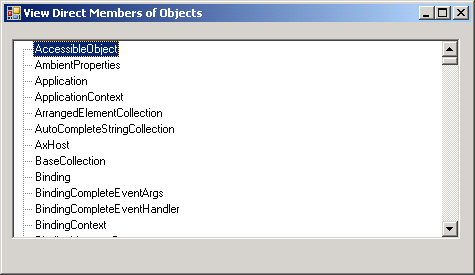Add all Public Assembly Form Type

Imports System
Imports System.Drawing
Imports System.Reflection
Imports System.Windows.Forms
public class MainClass
Shared Sub Main()
Dim form1 As Form = New Form1
Application.Run(form1)
End Sub
End Class
Public Class Form1
Inherits System.Windows.Forms.Form
#Region " Windows Form Designer generated code "
Public Sub New()
MyBase.New()
'This call is required by the Windows Form Designer.
InitializeComponent()
End Sub
'Form overrides dispose to clean up the component list.
Protected Overloads Overrides Sub Dispose(ByVal disposing As Boolean)
If disposing Then
If Not (components Is Nothing) Then
components.Dispose()
End If
End If
MyBase.Dispose(disposing)
End Sub
Friend WithEvents treeView1 As System.Windows.Forms.TreeView
'Required by the Windows Form Designer
Private components As System.ComponentModel.IContainer
'NOTE: The following procedure is required by the Windows Form Designer
'It can be modified using the Windows Form Designer.
'Do not modify it using the code editor.
<System.Diagnostics.DebuggerStepThrough()> Private Sub InitializeComponent()
Me.treeView1 = New System.Windows.Forms.TreeView()
Me.SuspendLayout()
'
'treeView1
'
Me.treeView1.Anchor = (((System.Windows.Forms.AnchorStyles.Top Or System.Windows.Forms.AnchorStyles.Bottom) _
Or System.Windows.Forms.AnchorStyles.Left) _
Or System.Windows.Forms.AnchorStyles.Right)
Me.treeView1.ImageIndex = -1
Me.treeView1.Location = New System.Drawing.Point(8, 16)
Me.treeView1.Name = "treeView1"
Me.treeView1.SelectedImageIndex = -1
Me.treeView1.Size = New System.Drawing.Size(448, 200)
Me.treeView1.Sorted = True
Me.treeView1.TabIndex = 0
'
'Form1
'
Me.AutoScaleBaseSize = New System.Drawing.Size(5, 13)
Me.ClientSize = New System.Drawing.Size(467, 248)
Me.Controls.AddRange(New System.Windows.Forms.Control() {Me.treeView1})
Me.Name = "Form1"
Me.Text = "View Direct Members of Objects"
Me.ResumeLayout(False)
End Sub
#End Region
Private Function StripType(ByVal s As String) As String
Dim spacepos As Integer
spacepos = InStr(s, " ")
If spacepos > 0 Then Return Mid$(s, spacepos + 1)
Return (s)
End Function
Private Sub Form1_Load(ByVal sender As Object, _
ByVal e As System.EventArgs) Handles Me.Load
Dim asm As [Assembly]
Dim asmtypes() As Type
Dim ThisType As Type
asm = Reflection.Assembly.GetAssembly(GetType(System.Windows.Forms.Form))
asmtypes = asm.GetTypes()
For Each ThisType In asmtypes
If ThisType.IsClass And ThisType.IsPublic Then
Dim tn As New TreeNode(ThisType.Name)
treeView1.Nodes.Add(tn)
End If
Next
End Sub
End Class
Related examples in the same category